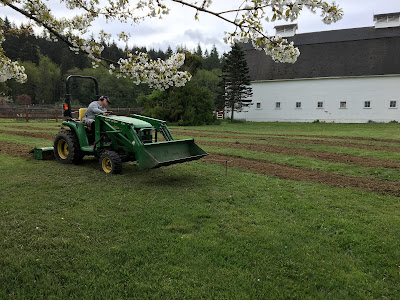An opportunity presented itself and we took the plunge: we're starting a blueberry farm! This wasn't an overnight decision as we've actually spent a number of years considering and calculating and planning what it would take. But the decision to do it now was sudden. We hadn't even prepared our blueberry field when we bought our first 100 blueberry bushes! The 3-year-old blueberry plants thankfully aren't root bound, and so they are doing quite well hanging out in the garden enclosure where they are safe from the deer. Meanwhile, we are working diligently toward getting the blueberry field established.
With the disruptions we are all seeing in the food supply chain, local seems to be the best option for food security. We've been doing all we can to grow our produce right here. This year we expanded our garden and also invited a friend and their family to join us with a patch dedicated to them. We might even have enough to sell produce to neighbors or at the Saturday Market. We've also been looking at propagating plants to sell, using heirloom varieties that are already established and spreading on our property, such as our raspberries. Next year, we are hoping to add honeybees and either goats or pigs to our farm. Adding blueberries to the mix right now is an enormous, exciting step. We've been thinking this could be a u-pick farm, with most sales to neighbors and the surrounding community. And of course, a huge blueberry harvest for our own enjoyment. I can't wait to eat fresh, organic blueberries right off the bush, and make blueberry pies, muffins and jam, and have an abundance of blueberries for putting in my freezer for our family to enjoy all year long.
To prepare our blueberry field, we first selected a field on our property that receives full sun and that has the most fertile soil. Of course, that is right next to the barn.
We tilled 6 long rows that are about 4 feet wide, leaving a 5 foot strip of grass between each row. Then I got out my shovel, thinking I could dig down a short bit further in the now soften soil to create the hole needed. That didn't go so well. Although we encountered zero rocks in this area, the soil had not been tilled here before (possibly ever!), and so deeper down where the tiller blades had not yet reached there was still very hard packed soil.
A tractor proves its worth on a farm in situations like these. We put the auger attachment on the tractor and my husband made quick work of drilling 100 beautiful, perfect holes into the earth. I helped measure the distance between each hole. Incredibly, we finished prepping the holes in just one hour.
Blueberries thrive in acidic soil, and so the next step was to test the soil pH and make adjustments to get it into the range of 4.5 to 4.8. For now to get the plants established we are adjusting the pH by incorporating sphagnum peat moss into the soil. The plants also need the soil to stay moist (but with good drainage), and so we're going to put down a shredded bark mulch over the soil to protect from the hot sun. Running water lines out there is another step we need to figure out. Believe it or not, we found the best solution for water right now is running a hose from the laundry room sink out the garage to the field. Eventually, since we have water rights to the creek, we'd like to put in a pump and irrigation system that taps into that water source instead - but that project will probably wait until next year.
Another issue we are looking at how to address is cross-pollination. We purchased 100 Duke blueberry bushes, which is an early season highbush variety that has high yields of large berries. We need to intermix our Duke blueberry bushes with another type of highbush for cross-pollination, in order to take advantage of greater yields. We already have four different blueberry bushes established in our garden that we plan to move to the blueberry field. Our neighbor Brian, upon seeing our little farm going in, gave us 6 blueberry bushes that they dug out of a property they are selling. By placing these extra blueberry bushes strategically throughout the field, we can begin to address the issue of cross-pollination.
Last on the list to get started is to put netting over the field to protect it from the birds and the deer. Our netting is on order; we're anxiously awaiting for it to be delivered. The netting will be suspended by simple hoops made from PVC pipe and rebar, which will be set up in a similar way to doing row covers in a garden. It will be a few years before our bushes get tall enough to outgrow the netting hoops - at which point, we'll put in something more permanent for a netting structure.






Comments
Post a Comment
Thank you so much for submitting a comment! All comments are reviewed by our moderator before being posted to the blog, in an effort to help control spam.